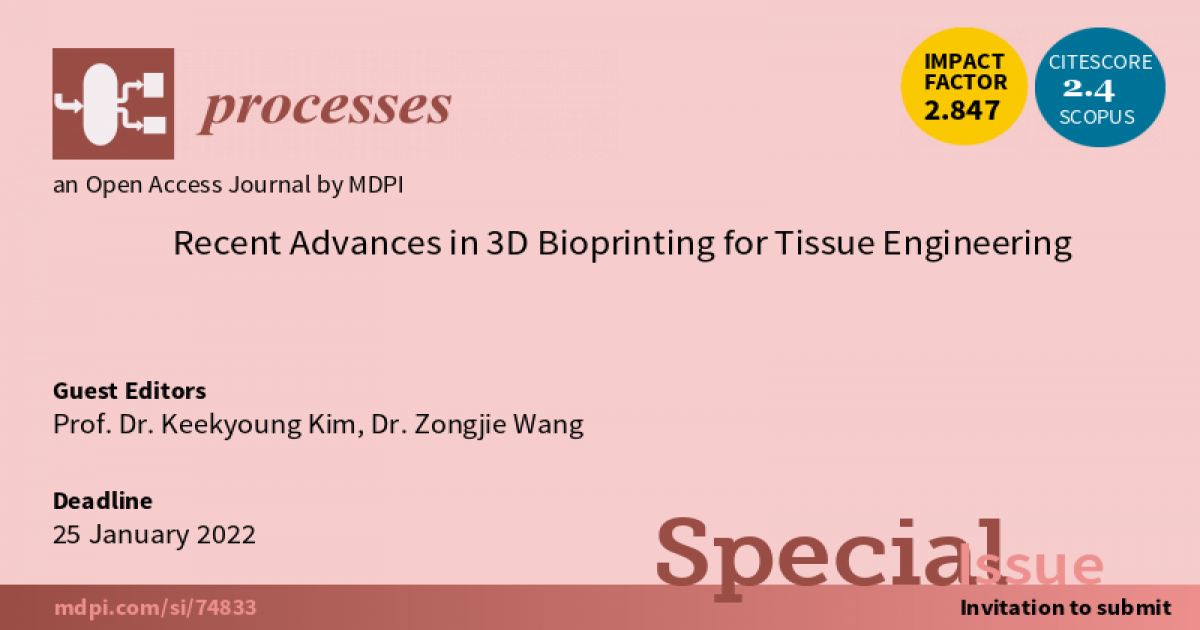Recent Advances in 3D Bioprinting for Tissue Engineering
A special issue of Processes (ISSN 2227-9717). This special issue belongs to the section "Biological Processes and Systems".
Deadline for manuscript submissions: closed (25 January 2022) | Viewed by 6438

Special Issue Editors
Interests: 3D bioprinting; BioMEMs; tissue engineering; biomaterials
Interests: biofabrication; biomicrofluidics; biointerface; cell therapy; precision medicine; mechanobiology; stem cells; regenerative medicine
Special Issues, Collections and Topics in MDPI journals
Special Issue Information
Dear Colleagues,
Native tissues organize themselves at the microscale level, and therefore it is rational to assemble tissue-like constructs at the microscale to accurately recapitulate their biological functions. The presence of 3D bioprinting, an automated process that precisely dispenses cell-laden biomaterials, has revolutionized the construction of 3D functional tissues in vitro thanks to its great biocompatibility, controllability, cost-effectiveness, and reproducibility. In recent years, the rapid development in 3D bioprinting enabled researchers to build artificial organs with unprecedented anatomical integrity and phenomenal biofunctionality, including human-sized hearts with synchronized contractions and perfusable multivascular networks within solid tissues. Such fabricated constructs have become an emerging standard for drug testing, disease modeling, and tissue regeneration.
To celebrate and summarize the tremendous growth in the field, this Special Issue aims to curate state-of-the-art reviews and original research articles regarding 3D bioprinting, including but not limited to:
- The development and characterization of new biomaterials and bioinks;
- The development and optimization of bioprinting approaches;
- The realization and standardization of bioprinting processes;
- Applications of bioprinted constructs in vitro, such as drug screening and disease modeling;
- Applications of bioprinted constructs in vivo, such as tissue regeneration;
- Pre-clinical/clinical translation and validation of 3D bioprinting.
Prof. Dr. Keekyoung Kim
Dr. Zongjie Wang
Guest Editors
Manuscript Submission Information
Manuscripts should be submitted online at www.mdpi.com by registering and logging in to this website. Once you are registered, click here to go to the submission form. Manuscripts can be submitted until the deadline. All submissions that pass pre-check are peer-reviewed. Accepted papers will be published continuously in the journal (as soon as accepted) and will be listed together on the special issue website. Research articles, review articles as well as short communications are invited. For planned papers, a title and short abstract (about 100 words) can be sent to the Editorial Office for announcement on this website.
Submitted manuscripts should not have been published previously, nor be under consideration for publication elsewhere (except conference proceedings papers). All manuscripts are thoroughly refereed through a single-blind peer-review process. A guide for authors and other relevant information for submission of manuscripts is available on the Instructions for Authors page. Processes is an international peer-reviewed open access monthly journal published by MDPI.
Please visit the Instructions for Authors page before submitting a manuscript. The Article Processing Charge (APC) for publication in this open access journal is 2400 CHF (Swiss Francs). Submitted papers should be well formatted and use good English. Authors may use MDPI's English editing service prior to publication or during author revisions.
Keywords
- 3D bioprinting
- additive manufacturing
- biofabrication
- biomaterials
- BioMEMs
- drug discovery
- disease modeling
- tissue engineering
- regenerative medicine
Benefits of Publishing in a Special Issue
- Ease of navigation: Grouping papers by topic helps scholars navigate broad scope journals more efficiently.
- Greater discoverability: Special Issues support the reach and impact of scientific research. Articles in Special Issues are more discoverable and cited more frequently.
- Expansion of research network: Special Issues facilitate connections among authors, fostering scientific collaborations.
- External promotion: Articles in Special Issues are often promoted through the journal's social media, increasing their visibility.
- Reprint: MDPI Books provides the opportunity to republish successful Special Issues in book format, both online and in print.
Further information on MDPI's Special Issue policies can be found here.






